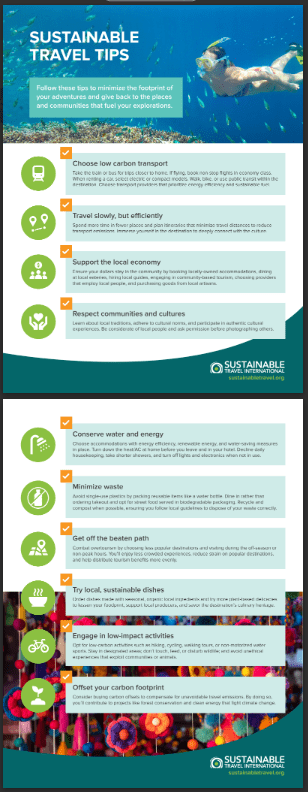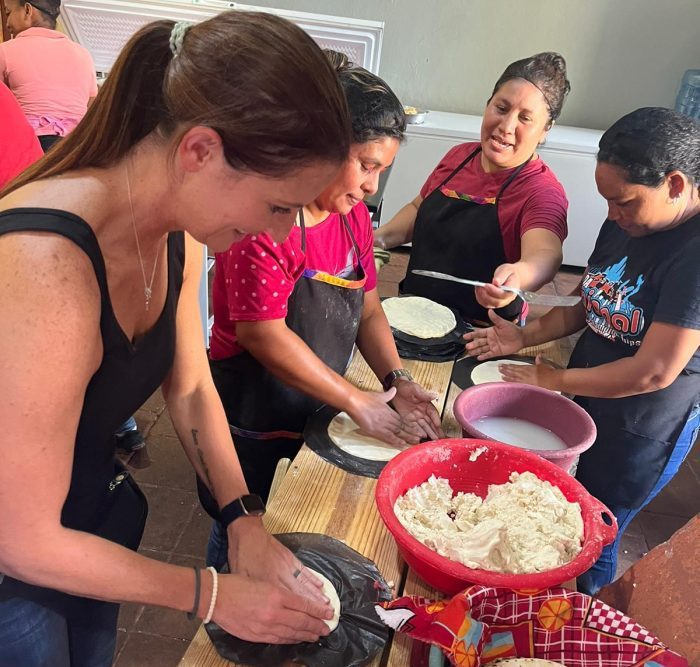When a nonprofit’s co-founders are a compassionate sociologist and a professor whose eyes light up when she gets to explain the impact of the slave trade on the development of drumming from Brazil to the islands, the fact that they have been “on trend” with sustainable travel long before others started addressing the issue is really no surprise.
As Global Studies Director at Bethel University in rural West Tennessee for more than a decade, Stacie Freeman soon realized experiential learning was key to successfully introducing teens in her dual enrollment and young adults in her college classes to the study of human society. What better way to focus on human social behavior, patterns of social relationships, social interaction, and aspects of culture associated with everyday life than going beyond small town city limits and across international borders to serve and learn with those “not quite like me.”
A transformational encounter with percussionists using their art to rescue young Brazilians from street life via the music they loved, led Dr. Julie Hill to a deeper commitment to introducing her students to not simply new forms of music but how historical events shaped entire genres.
So, they formed Global Citizen Adventure Corps in 2023 with the intent of creating travel service learning paths for their small town neighbors and those whose financial status meant a summer trip was to the nearby lake if they were lucky enough to have the means to get there. They knew then that GCAC would never be a “typical tour company.”
What’s Different About GCAC Programs
First, they made it a nonprofit so they could raise funds to help provide scholarships. Secondly, they made support of UN Sustainable Development Goals a foundational element of each program they planned. Addressing poverty, decent work and economic growth, quality education, conservation of land and animals, and good health and well-being were the guidelines as they sought to choose and build partnerships with in-country nonprofits for service projects. And, ultimately, they agreed to and crafted a mission that only succeeds when participants increase mutual respect for people, places, and the planet upon their return. Global Citizen Adventure Corps now offers short-term travel experiences created with a delicate and yet critical tension.
“The programs are brief to maximize school breaks. They must be equal parts fun and fascinating as we lean into learning, answer a community-identified need as we serve, and support our values regarding sustainability as we travel to faraway lands,” said Freeman. “We work hard. We play hard. And we want to ensure that the majority of what we leave behind are good memories and not a negative environmental impact.”
“We work hard. We play hard. And we want to ensure that the majority of what we leave behind are good memories and not a negative environmental impact.” – Stacie Freeman
What’s Challenging About GCAC Programs
Threatening that delicate balance are considerations such as the need to fill programs which are not always on individuals’ bucket lists.
“France and Italy are on so many people’s radars. They tend to be a fast sell, and their popularity helps pay the bills for the scholarships we desperately need to ensure our target audience can experience life-changing service programs in the other areas we go such as Guatemala and Honduras,” explained Hill. “But popular sites are when terms like ‘overtourism’ apply.”
What’s the Problem with Overtourism
Overtourism occurs when too many visitors are descending on too little space. Problems include erosion as thousands trample on historical and sacred sites, housing as apartments are turned into vacation rentals, pollution as cruise ships arrive in ports, and the struggle of leaders as they juggle positive economic impact with detrimental setbacks to their citizenry. (For more on the subject of overtourism, check out Sustainable Travel International’s blog post “What Is Overtourism and Why Is It a Problem?“)
In an article by Kate Leahy in National Geographic, the numbers paint a bleak two-sided picture. The Covid pandemic meant tourism declined. One source estimated international tourist arrivals dropped 72% in 2020. In the fall of 2023 those numbers were in a rapid incline with the World Travel Tourism Council noting tourism was at 95% of its pre-pandemic levels. And forecasts suggest that the industry will be 11.6% of the global economy by 2033.
Leahy goes on to point to a 2022 survey by Booking.com that saw 64% of the people asked indicating they would be prepared to stay away from busy tourist sites to avoid adding to congestion.
That’s the mindset that falls into the category of “sustainability.”
What’s Sustainability Look Like
According to the organization Sustainable Travel International, “Travel companies can … play a crucial role by planning trips and offering tourism experiences that alleviate pressure on over-visited destinations, creating meaningful community benefits, and educating visitors and nudging them toward more sustainable practices.”
GCAC – a travel company – was built on those very principles – creating meaningful community benefits and educating visitors and nudging them toward more sustainable practices.
“We were ‘sustainability-focused’ before that was the buzzword,” said Freeman of the groundwork she laid for GCAC as she developed experiences in Costa Rica, Colombia, Honduras, and Thailand for Bethel’s global studies in the decade prior to GCAC’s creation. “We were practicing before it became a best practice.”
But how does GCAC pull off “sustainability” while still providing international travel (planes must be involved!) and experiences that appeal to both the compassionate (those ready to serve) and the curious (those wanting to know more about places they have heard of their entire lives).
Sustainable Travel International says its simple actions like visiting at off-peak times, respecting cultural norms, reducing waste, and supporting local businesses that can make a difference. They offer the following tips:
- Choose low carbon transport
GCAC programs are booked by Student Universe whose carbon consciousness includes searching for flights with the fewest stops and choosing economy class tickets. GCAC limits baggage to carry-on only to minimize the load the plane carries. Transportation in the country is by bus when possible and/or train rather than back in the air. Lodging is located near the planned sights so that walking tours are convenient.
- Travel slowly, but efficiently
GCAC programs visit fewer places and so that deep connections with the culture win out over ticking off a laundry list of “been there, done that, got the t-shirt” attractions.
- Support the local economy
GCAC books locally-owned accommodations. Volunteers dine at local eateries, Local guides provide community-based tourism, and shopping is done at local markets with tourism dollars spent on goods from local artisans
- Respect communities and cultures
GCAC is unique in that participants earning scholarships must take a course taught by Freeman for college credit that unpacks what it means to be a global citizen respecting local traditions, adhering to cultural norms, and participating in authentic cultural experiences. As part of the pledge each GCAC participant signs before travel they commit to respect and consideration of local people and nonprofit partners by doing things such as asking permission before photographing others.
- Conserve water and energy
GCAC seeks out locally owned accommodations with energy efficiency, renewable energy, and water-saving measures in place. Frequently, AC is not an option and when it is, care is given to encourage rationed use. Participants are informed on the need to take shorter showers, and turn off lights and electronics when not in use.
- Minimize waste
Each participant is gifted a GCAC thermos on departure day to avoid single-use plastics. The excessive waste of packaging fast food and takeout are avoided as groups dine in local restaurants or with families.
- Get off the beaten path
Off-season and non-peak hours for visits in less popular but equally fascinating locales are part of GCAC’s strategy to enjoy less crowded experiences, reduce strain on popular destinations, and help distribute tourism benefits more evenly.
- Try local, sustainable dishes
“To know what’s in another’s heart, understand what’s in their bellies” could easily serve as an adage for a GCAC program. Culture is revealed as dining experiences spotlight dishes made with seasonal, organic local ingredients (thereby lessening the “foodprint,” and supporting local producers) while savoring the destination’s culinary heritage.
- Engage in low-impact activities
Keeping costs low means more first-time travelers can afford to go (especially when they also show need and receive a GCAC scholarship) so GCAC programs are filled with low-carbon activities such as hiking, walking tours, or non-motorized water sports. Some of the most popular GCAC service projects involve the rescue and care of animals and always with the respect for the nonprofit’s rules of engagement without exploitation.
- Offset your carbon footprint
As a young nonprofit, GCAC is currently focused on the mission of making travel service learning within financial reach of participants. So this particular tip is more aspiration than realization. However,GCAC works to find like-minded partners such as Student Universe who can automatically calculate how many carbon credits are needed to offset the carbon emissions from flights and offers the option of purchasing those credits at the time of booking. With the right carbon-conscious sponsor who would take on covering this aspect of travel, GCAC could easily make service learning include serving the future of the planet with contributions to projects like forest conservation and clean energy that fight climate change.
“We were thrilled when we saw such a respected group as Sustainable Travel International come out with a list of tips and best practices that reflect exactly the kind of thinking that goes into each of our programs,” said Hill.
Freeman agrees, “As educators, both Julie and I know that lectures are rarely the source of transformative learning but put those same students in another country seeing and experiencing first hand cause and effect, culture and customs, and we believe we will return with individuals committed to a brighter, cleaner, healthier future.”
We were thrilled when we saw such a respected group as Sustainable Travel International come out with a list of tips and best practices that reflect exactly the kind of thinking that goes into each of our programs. – Julie Hill


